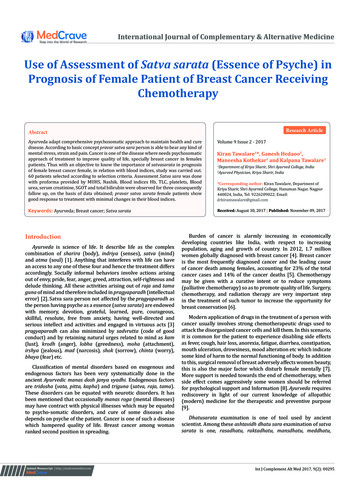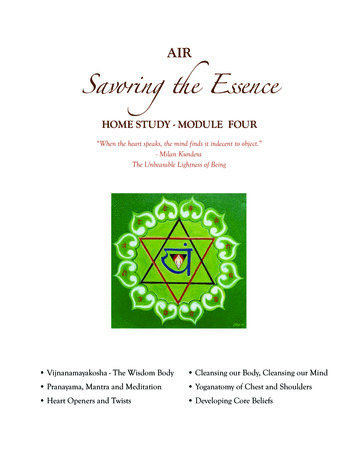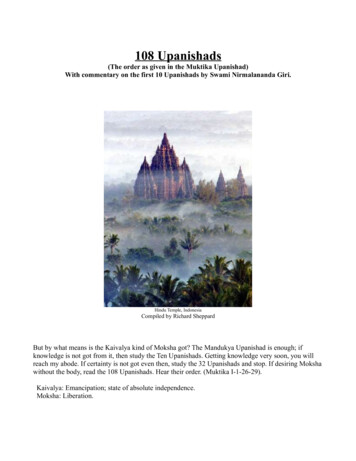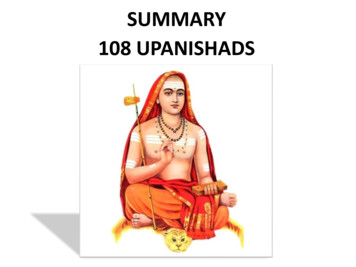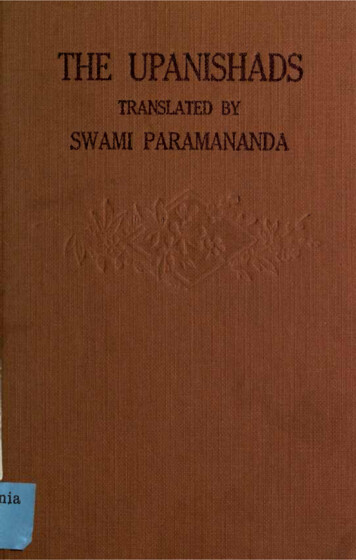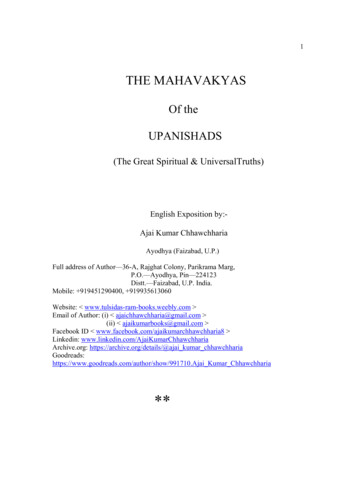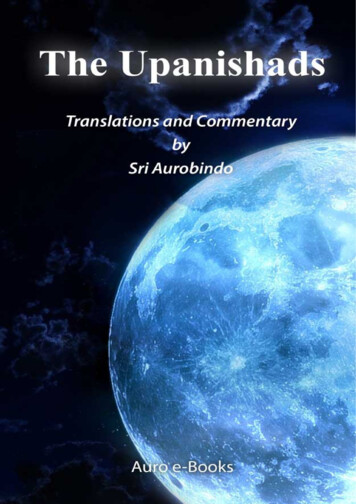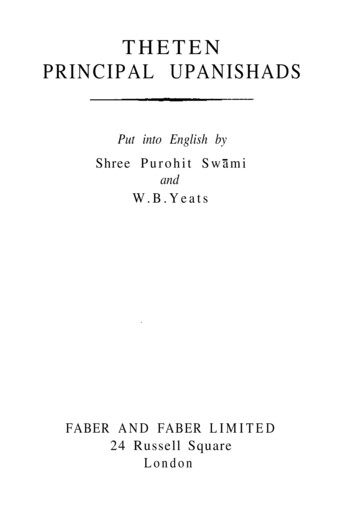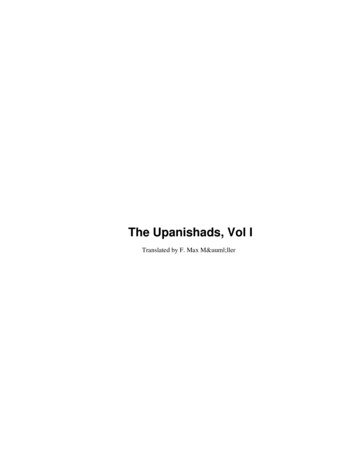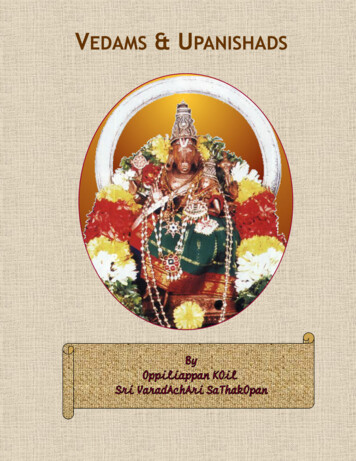
Transcription
e s s e n c e o f t h e u pa n i s ha d sHoU.indb 13/8/09 5:41:14 PM
the wisdom of india Essence of the Upanishadsforthcoming:Essence of the Bhagavad GitaEssence of the DhammapadaEssence of YogaHoU00.indd 23/10/09 2:54:30 PM
Essence of theU PA N I S H A D SA Key to Indian Spirituality E k n at h E a s wa r a nnilgiri pressHoU.indb 33/8/09 5:41:14 PM
1981, 1992, 2009 by The Blue Mountain Center of MeditationAll rights reserved. Printed in CanadaRevised and updated edition of Dialogue with Death:The Spiritual Psychology of the Katha UpanishadFirst printing this edition: May 2009i s b n : 978–1–58638–036–6Library of Congress Control Number: 2008943476Printed on 100% post-consumer recycled paperCataloging-in-Publication Data will be foundon the last page of this book.Nilgiri Press is the publishing division of the Blue MountainCenter of Meditation, a nonprofit organization foundedby Eknath Easwaran in 1961. The Center also offers retreatsbased on the eight-point program of passage meditation thatEaswaran developed and practiced. For information please visitwww.easwaran.org, call us at 800.475.2369 (USA and Canada)or 707.878.2369 (international and local), or write to us atthe Blue Mountain Center of Meditation, Box 256, Tomales,CA 94971–0256, USA.HoU.indb 43/8/09 5:41:14 PM
Table of ContentsPreface: The Wisdom of India 7Introduction 11T h e M y t h : A D i a l o g u e w i t h D e at h1 An Inward Journey 232 Two Paths 41T h e T e a c h i n g : T h e J o u r n e y o f S e l f - D i s c o v e ry3 The City of Eleven Gates 574 Gross & Subtle 735 A Field of Forces 936 Will & Desire 1117 Clear Seeing 1298 The Stream of Thought 1519 Shadow & Self 17510 Death & Dreaming 19511 Waking Up 21512 The Lesson of the Lilac 241Further Reading 263The Katha Upanishad 265Index 287HoU.indb 53/8/09 5:41:14 PM
to christineHoU.indb 63/8/09 5:41:14 PM
pr e fac e The Wisdom of IndiaS o m e y e a r s a g o I translated what Icalled the Classics of Indian Spirituality: the Upanishads, theBhagavad Gita, and the Dhammapada. These ancient texts,memorized and passed from generation to generation for hundreds of years before they were written down, represent earlychapters in the long, unbroken story of India’s spiritual experience. The Upanishads, old before the dawn of history, come tous like snapshots of a timeless landscape. The Gita condensesand elaborates on these insights in a dialogue set on a battlefield,as apt a setting now as it was three thousand years ago. And theDhammapada, a kind of spiritual handbook, distills the practical implications of the same truths presented afresh by theCompassionate Buddha around 500 BC .These translations proved surprisingly popular, perhapsbecause they were intended not so much to be literal or literaryas to bring out the meaning of these documents for us today. Forit is here that these classics come to life. They are not dry texts;they speak to us. Each is the opening voice of a conversationwhich we are invited to join – a voice that expects a reply. Soin India we say that the meaning of the scriptures is only com7HoU.indb 7 3/8/09 5:41:14 PM
p r e fa c eplete when this call is answered in the lives of men and womenlike you and me. Only then do we see what the scriptures meanhere and now. G. K. Chesterton once said that to understand theGospels, we have only to look at Saint Francis of Assisi. Similarly,I would say, to grasp the meaning of the Bhagavad Gita, we needlook no farther than Mahatma Gandhi, who made it a guide forevery aspect of daily living. Wisdom may be perennial, but tosee its relevance we must see it lived out.In India, this process of assimilating the learning of the headinto the wisdom of the heart is said to have three stages: shravanam, mananam, and nididhyasanam; roughly, hearing, reflection, and meditation. These steps can merge naturally into asingle daily activity, but they can also be steps in a journey thatunfolds over years. Often this journey is begun in response toa crisis. In my own case, though I must have heard the scriptures many times as a child, I don’t remember them makingany deep impression. When I discovered the Bhagavad Gita, Iwas attracted by the beauty of its poetry; I didn’t understand itsteachings at all. It was not until I reached a crisis of meaning inmy mid-thirties, when outward success failed to fill the longing in my heart, that I turned to these classics for wisdom ratherthan literary beauty. Only then did I see that I had been, as theBuddha puts it, like a spoon that doesn’t know the taste of thesoup.Since that time I have dedicated myself to translating thesescriptures into daily living through the practice of meditation.The book in your hands is one fruit of this long endeavor. Sucha presentation can only be intensely personal. In my translations I naturally let the texts speak for themselves; here I makeno attempt to hide the passion that gave those translations their HoU.indb 883/8/09 5:41:14 PM
The Wisdom of India appeal. To capture the essence of the Gita, the Upanishads, andthe Dhammapada, I offer what I have learned personally fromtrying to live them out in a complex, hurried world. I write notas a scholar, but as an explorer back from a long, long voyageeager to tell what he has found.Yet however personal the exploration, these discoveries areuniversal. So it is not surprising that at the heart of each of theseclassics lies a myth – variations on the age-old story of a hero inquest of wisdom that will redeem the world. In the Upanishads,a teenager goes to the King of Death to find the secret of immortality. In the Gita, standing between opposing armies on theeve of Armageddon, the warrior-prince Arjuna seeks guidancefrom an immortal teacher, Sri Krishna. And behind the Dhammapada lies the story of the Buddha himself, a true story woveninto legend: a prince who forsakes his throne to find a way for allthe world to go beyond sorrow in this life. These old stories areour own, as relevant today as ever. Myth always involves the listener. We identify with its heroes; their crises mirror ours. Theirstories remind us not only what these scriptures mean but whythey matter. Like the texts themselves, they seek a response inour own lives.So this book is both the fruit of a journey and an invitation.If you like, you may read it as a traveler’s tale rich in the experience of some distant place, enjoying the sights and adventureswithout the travail of actually making the trip yourself. But thisplace is really no more distant than the heart, so if you find thatthis description calls you to your own voyage of exploration, myhighest purpose in writing will be fulfilled.9HoU.indb 9 3/8/09 5:41:14 PM
Editors’ NoteThis is a new and thoroughly revised edition of a book originallytitled Dialogue with Death: The Spiritual Psychology of the Katha Upanishad. We have added a previously unpublished introduction andmade some minor revisions – including the removal of dated references – suggested by the author before his death, in 1999. Otherthan that, the text stands as he left it. Though some of his examplesare no longer current, the problems and principles they illustrateremain relevant: the Cold War, for example, may be behind us, yet theglobal threat of arms races and nuclear weapons is as urgent as ever.HoU00.indd 103/10/09 2:55:19 PM
IntroductionT h i s i s a personal exploration of the fundamental ideas of the Upanishads, among the earliest sourcesof Indian spirituality, and the light they throw on how to livetoday. My focus is practical: what I have found most meaningful in my own life, after decades of the practice and teaching ofmeditation.The Upanishads are probably the oldest body of wisdom literature in the world. Though removed from us by thousands ofyears, the insights they give into the nature of the phenomenalworld, the human mind, and the underlying reality called Godare as dazzling today as ever. And the questions they pose neverbecome dated. They are new for every human being, fresh forevery generation, because they are questions that each of us hasto answer for ourselves.Out of hundreds of these documents, one in particularappeals to me as the essence of the Upanishads. Lyrical, dramatic, practical, inspiring, the Katha Upanishad embraces thekey ideas of Indian mysticism and presents them in the contextof a mythic adventure that everyone can relate to: the story of11HoU.indb 11 3/8/09 5:41:14 PM
introductiona young hero who ventures into the land of death in search ofimmortality.Following this cue, I have laid out this book too like a journey.In the Katha, insights are scattered without regard to order, likeflares bursting at random to illumine a hidden landscape; andthe central concepts are taken for granted, which can be baffling for readers in a different culture thousands of years later.Here those concepts and insights are presented systematicallyin the course of exploring deeper and deeper levels of personality. Taken this way, the Katha provides a comprehensive answerto the central question of all philosophy, Who am I? – which, ofcourse, is not just an end but a beginning.The UpanishadsThe Upanishads are the earliest instance in history of the perennial philosophy: the discovery that beneaththe incessant change of the phenomenal world lies a changelessreality that can be discovered deep in consciousness by following disciplines that are essentially the same regardless of cultureor religion. Spinoza might have been quoting the Upanishadswhen he summed up this discovery thousands of years later inone simple sentence: “The finite rests upon the Infinite, and theInfinite is God.”This is the language of philosophy, but the Upanishads arenot philosophy. They do not state opinions, expound theories, ordictate dogma. They record experience, direct encounters witha land beyond change. In Sanskrit they are darshana, “sightings.”How old they are we cannot know; long before they were written down, they were passed from generation to generation in ameticulously faithful oral tradition still practiced today, so that HoU.indb 12123/8/09 5:41:14 PM
introduction by the time they emerge in written form, they seem almost tocome from beyond the beginning of time.Given this antiquity, it is amazing how directly they speak tous now. We hear in them the “voice of the Eternal,” always immediate, always new, always seeming to speak to each of us personally – to you and me. This should not surprise us. The Upanishads are ageless precisely because they describe realities thatdo not change. And that is how they have always been reveredin India: not as written works but as elements of an immutable landscape, the very bedrock of reality. Explorers seeing theHimalayas for the first time record what they see, but the recordsare not the experience. The Upanishads are like the experienceitself, a vision with no barrier between observer and observed,as breathtakingly beyond words as one’s first glimpse of Everestshimmering at the crown of the world.Yet they have been put into words, so each Upanishadstrains language with the passion to communicate what cannot be expressed. Reading them reminds me of that extraordinary scrap of paper on which Blaise Pascal recorded a similarencounter – a precocious mathematician and one of the fineststylists in the French language so struck dumb by this experience that he can only scrawl down fragments:From about half past ten till about half past midnightfireGod of Abraham, God of Isaac, God of Jacobnot of the philosophers and scholarsCertitude. Certitude. Feeling. Joy. Peace.Pascal was writing solely for himself, but other mastersof language before and after him failed equally at the task of13HoU.indb 13 3/8/09 5:41:15 PM
introduction putting this experience into words. Thomas Aquinas, after asimilar encounter towards the end of his life, simply wrote, “Allthat I have written” – virtually the whole foundation of Catholic theology – “now seems no more than straw.” Shankara, an Indianmystic of equal authority, was more poetic: “Words turn backfrightened there, unable to cross.” And Mechthild of Magdeburg,lyrical even in her prose, confides, “Of the holy things that Godhas shown me, I can speak no more than a single word – nomore than a honeybee can carry away on its feet from an overflowing jar.”Whatever this experience is, though beyond words, it is fullof meaning; we can see that from the transformation of personality that follows. Yet how can ordinary people like you and mehope to learn from the records of such experiences if ineffability and random insight are their hallmarks? Some might say wecannot; we must simply take them as they are. But today especially there must be many who, like me, need not only to wonderbut to understand; and for that, words and intellectual discrimination must be pressed back into service to give at least somesense of what is beyond their reach.Like explorers describing the same scene from different vantages, each Upanishad throws out these random, ineffablesnapshots of a transcendent reality from its own point of view.If we could put these visions all together, we might have a mapthat brings into clear relief the whole inner geography of thespirit.Yet the Upanishads themselves provide no such map, andwithout one, it is difficult to assemble these fragments into acoherent whole. In addition, however they may thrill and inspireus, their practical meaning is often far from clear: so obscure, HoU.indb 14143/8/09 5:41:15 PM
introduction in fact, that even to their contemporaries, the word upanishadcame also to mean “secret” because to understand them requiresthe practice of spiritual disciplines – a long drawn-out anddemanding affair that excludes those unwilling to make it thefocus of their lives.In other words – not surprisingly, perhaps – to understandthe Upanishads, one must actually go to their source oneself. Theresult is almost paradoxical: mystics from
The Upanishads, old before the dawn of history, come to us like snapshots of a timeless landscape. The Gita condenses and elaborates on these insights in a dialogue set on a battlefield, as apt a setting now as it was three thousand years ago. And the Dhammapada, a kind of spiritual handbook, distills the prac- tical implications of the same truths presented afresh by the Compassionate Buddha .

